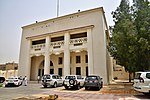Jeddah Islamic Port
Buildings and structures in JeddahEconomy of JeddahGeography of JeddahPorts and harbours of Saudi ArabiaPorts and harbours of the Red Sea ... and 3 more
Transport in JeddahTransport in the Arab LeagueVague or ambiguous time from July 2021

Jeddah Islamic Port is a Saudi Arabian port, located in Jeddah on the Red Sea, at the middle of an international shipping route between the east and west via the Suez Canal. It is the second-largest and second-busiest port in the Arab world (after the Port of Jebel Ali in Dubai, UAE). The city of Jeddah is the second-largest city in Saudi Arabia (after the capital Riyadh), and is Saudi Arabia's commercial capital.
Excerpt from the Wikipedia article Jeddah Islamic Port (License: CC BY-SA 3.0, Authors, Images).Jeddah Islamic Port
Al Andalus Road,
Geographical coordinates (GPS) Address Nearby Places Show on map
Geographical coordinates (GPS)
| Latitude | Longitude |
|---|---|
| N 21.483843 ° | E 39.173406833333 ° |
Address
شراع برج الميناء الاسلامي Al Hendawiya, Makkah, Saudi Arabia
Al Andalus Road
22233
Makkah Region, Saudi Arabia
Open on Google Maps






